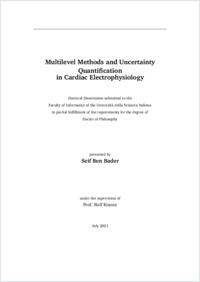Multilevel methods and uncertainty quantification in cardiac electrophysiology
- Ben Bader, Seif
- Krause, Rolf (Degree supervisor)
- 2021
PhD: Università della Svizzera italiana, 2021
Uncertainty quantification
Cardiac electrophysiology
Monodomain equation
Space-time discretization
Parallel in time solver
Multilevel sampling methods
Quasi-monte carlo
English
The objective of this thesis is to build an efficient and powerful computational framework for addressing large scale Uncertainty Quantification (UQ) problems arising in cardiac electrophysiology. Cardiac models for reproducing the electrophysiological activity may suffer from a significant amount of uncertainties. These may be associated to the inherent physical and geometrical parameters of the model, as much as they could be induced by the imprecision of the model itself (e.g. uncertainty in the ion channel model). We here rely exclusively on the monodomain equation that represents a widely used model for computing the activation map of the cardiac cells. This model is highly anisotropic, as it strongly depends on the heart fibers’ directions. In this thesis, we evaluate the effect of spatially correlated perturbations of the heart fibers on the statistics of the resulting activation map. We rely on sampling methods that entail solving a numerous amount of times the computationally expensive monodomain model. The feasibility of such an approach is highly dependent on the efficiency of the computational framework. For this purpose, we introduce a new methodology which relies on a close integration of multilevel Monte-Carlo methods, parallel iterative solvers and a space-time all–at–once approach. This design allows for a fully parallelized framework in space, time, and stochastics. The following setting is further improved by taking advantage of space-time solutions of past samples in the initialization of the Newton’s method, resulting in a tremendous reduction of iterations for convergence. We numerically assess the described framework on three dimensional geometries. More precisely, we evaluate the convergence properties and compare the performances of classical Monte Carlo and quasi-Monte Carlo methods, as well as multilevel quadrature strategies. In particular, we consider multilevel Monte Carlo and multilevel quasi-Monte Carlo on hierarchies of nested meshes for the time–dependent non linear equation represented by the monodomain model. Finally, and as a synthesis of the following work, we use the reversed construction of the multilevel quadrature in order to adapt the multilevel (quasi-) Monte Carlo to the configuration of non-nested meshes of a realistic heart geometry.
- Collections
- Language
-
- English
- Classification
- Computer science and technology
- License
-
License undefined
- Open access status
- green
- Identifiers
-
- NDP-USI 2021INF015
- URN urn:nbn:ch:rero-006-121018
- ARK ark:/12658/srd1320996
- Persistent URL
- https://n2t.net/ark:/12658/srd1320996
Statistics
Document views: 309
File downloads:
- 2021INF015: 328
